Origin
| | This section is empty. You can help by adding to it. (November 2014) |
| Course | Main course |
|---|---|
| Place of origin | Puerto Rico |
| Serving temperature | Hot |
| Main ingredients | Rice, legume, sofrito, annatto |
| Variations | Locrio, Moros y Cristianos (food) |
| Other information | Popular throughout: Caribbean parts of Latin America |
Arroz junto (rice together) is a Puerto Rican rice dish cooked with beans and meat in one pot.
| | This section is empty. You can help by adding to it. (November 2014) |
Rice, beans, and usually some kind of meat, are combined in the same pot. Sofrito, meat, olives, capers and spices are cooked in annatto oil. Annatto adds flavor and tints the rice a bright orange color. Once sofrito is cooked, rice and beans are added with liquid.
Some arroz junto dishes are given other names such as arroz con gandules, arroz con maiz y salchichas, arroz con garbanzo y bacalao (rice with chickpeas and salted cod), and arroz bago (rice, chickpeas, and ground meat). Pinto, black or red beans are usually accompanied with smoked ham, longaniza, or bacon. Arroz con pollo is another popular dish that usually has added chorizo and sweet peas.
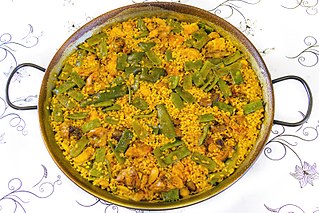
Paella is a rice dish originally from the Valencian Community. Paella is regarded as one of the community's identifying symbols. It is one of the best-known dishes in Spanish cuisine.

Puerto Rican cuisine consists of the cooking style and traditional dishes original to Puerto Rico. It has been primarily a fusion influenced by the ancestors of the Puerto Rican people: the indigenous Taínos, Spanish Criollos and sub-Saharan African slaves. As a territory of the United States, the culinary scene of Puerto Rico has also been moderately influenced by American cuisine.

Fried rice is a dish of cooked rice that has been stir-fried in a wok or a frying pan and is usually mixed with other ingredients such as eggs, vegetables, seafood, or meat. It is often eaten by itself or as an accompaniment to another dish. Fried rice is a popular component of East Asian, Southeast Asian and certain South Asian cuisines, as well as a staple national dish of Indonesia. As a homemade dish, fried rice is typically made with ingredients left over from other dishes, leading to countless variations. Fried rice first developed during the Sui Dynasty in China.

Arroz a la cubana or arroz cubano is a rice dish popular in Spain, the Philippines, and parts of Latin America. Its defining ingredients are rice and a fried egg. A fried banana and tomato sauce (sofrito) are so frequently used that they are often considered defining ingredients too.
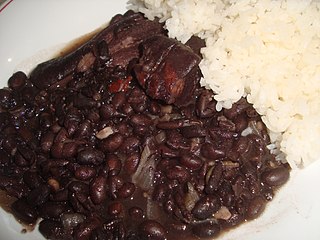
Moros y Cristianos is a traditional Cuban dish served both in homes and in restaurants. It is the Cuban version of rice and beans, a dish found throughout Latin America, the Caribbean, and in the Southern United States.

Rice and beans, or beans and rice, is a category of dishes from many cultures around the world, whereby the staple foods of rice and beans are combined in some manner. The grain and legume combination provides several important nutrients and many calories, and both foods are widely available. The beans are usually seasoned, while the rice may be plain or seasoned. The two components may be mixed together, separated on the plate, or served separately.

Arroz con pollo is a traditional dish of Latin America. It typically consists of chicken cooked with rice, onions, saffron, and a potential plethora of other grains or vegetables. In the Dominican Republic it is alternately called locrio de pollo, and in Saint Martin it is called lokri or locreo.

Picadillo is a traditional dish in many Latin American countries including Mexico and Cuba, as well as the Philippines. It is made with ground meat, tomatoes, and also raisins, olives, and other ingredients that vary by region. The name comes from the Spanish word picar, meaning "to mince".

Cuchifritos or cochifritos refers to various fried foods prepared principally of pork in Spanish and Puerto Rican cuisine. In Spain, cuchifritos are a typical dish from Segovia in Castile. The dish consists of pork meat fried in olive oil and garlic and served hot. In Puerto Rico they include a variety of dishes including morcilla, papas rellenas, and chicharron, and other parts of the pig prepared in different ways. Some cuchifritos dishes are prepared using plantain as a primary ingredient. Cuchifritos vendors also typically serve juices and drinks such as passionfruit, pineapple, and coconut juice, as well as ajonjolí, a drink made from sesame seeds.

Pasteles, also pastelles in the English-speaking Caribbean, are a traditional dish in several Latin American and Caribbean countries. In Puerto Rico, the Dominican Republic, Venezuela, Panama, Trinidad and Tobago, and the Caribbean coast of Colombia, the dish looks like a tamal. In Hawaii, they are called pateles in a phonetic rendering of the Puerto Rican pronunciation of pasteles, as discussed below.
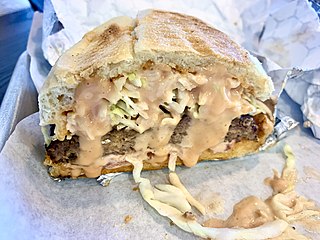
Dominican cuisine is made up of Spanish, indigenous Taíno, Middle Eastern, African, Cuban, Puerto Rican and Haitian influences. The most recent influences in Dominican cuisine are from the British West Indies and China.

Arroz a la valenciana or Valencian rice is a name for a multitude of rice dishes from diverse cuisines of the world, which originate from the rice-cooking tradition of the Valencian Community, in eastern Spain.
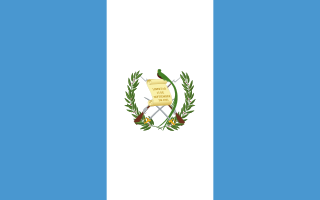
Most traditional foods in Guatemalan cuisine are based on Maya cuisine, with Spanish influence, and prominently feature corn, chilies and beans as key ingredients. Guatemala is famously home to the Hass avocado.

Arroz con gandules is a combination of rice, pigeon peas, and pork, cooked in the same pot with sofrito. This is Puerto Rico's national dish along with roasted pork.

Moro de guandules is a rice and pigeon pea dish from the Dominican Republic served on holidays.
Arroz con maíz is a Latin American dish with rice and corn cooked in one pot.
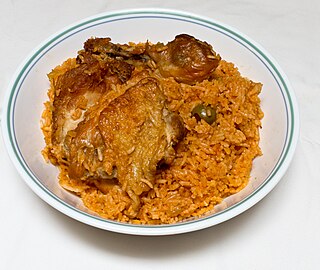
A locrio is a rice dish from the Dominican Republic. Similar to pilaf, jollof, and paella, it consists of seasoned rice with some kind of meat, such as chicken, Dominican salami or pork.

Paelya or paella (Spanish), is a Philippine rice dish adapted from the Valencian paella. However, it differs significantly in its use of native glutinous rice (malagkít), giving it a soft and sticky texture, unlike the al dente texture favoured in Spanish paella. It is also characteristically topped with sliced eggs. Filipino paelya does not use saffron, but is instead coloured with atsuete (anatto), luyang diláw (turmeric), or kasubhâ (safflower).
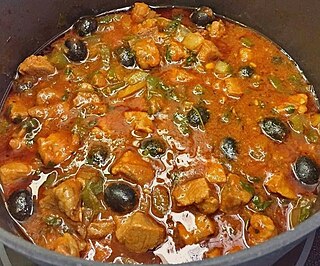
Pastele stew is a Hawaii inspired pork stew of Puerto Rican origin. It is an adaptation of the dish pasteles introduced by the Puertorriqueños who came to work on the sugar plantations in the early 1900s. Pastele making is often a laborious task reserved for special occasions and holidays such as Christmas. Pastele stew was developed as a simplified everyday version.